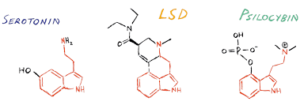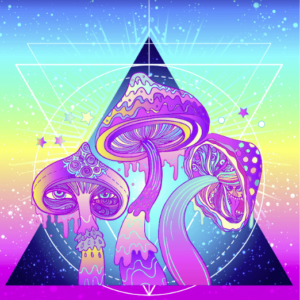Article Sections
- Patient Resources
- Treatment Options
- The Psilocybin Mushroom
 When we talk of mushrooms, we are referring to those containing psilocybin and psilocin. These two, closely-related chemicals have an indole-ring structure in their molecules, as do the other tryptamines used to treat clusters. It is psilocin which has both the psychedelic hallucinogenic and medicinal effects; the body quickly converts psilocybin into psilocin. (Illustration credit: The Third Wave)
When we talk of mushrooms, we are referring to those containing psilocybin and psilocin. These two, closely-related chemicals have an indole-ring structure in their molecules, as do the other tryptamines used to treat clusters. It is psilocin which has both the psychedelic hallucinogenic and medicinal effects; the body quickly converts psilocybin into psilocin. (Illustration credit: The Third Wave)
One theory is indole ring molecules have a shape that will fit certain kinds of receptors in the brain. Because of this, they influence the amount of serotonin at work in the brain; serotonin levels may have something to do with clusters. Since it is thought that some specific shapes of tryptamine molecules fit receptors better than others, some tryptamines seem to work better than others. Psilocin is a vasoconstrictor and may stop or prevent attacks by keeping the carotid artery from expanding and pressing on the trigeminal nerve.
There are many species of mushrooms that contain psilocybin and psilocin. They grow on all continents (except Antarctica) and in various climates. Many have the term “psilocybe” in their scientific names. Most mushroom grown by recreational users are of the species Psilocybe cubensis, mainly because they are potent and grow fast, but there are other species. Psilocybe cyanescens and Psilocybe semilanceata are about twice as strong as cubensis. Other species of Psilocybe may contain very little active ingredient. Because of the variability in potency, Clusterbusters recommends caution.
Growing in some areas are wild toxic mushrooms; these can be easily mistaken for psilocybin mushrooms. Ingesting them can lead to potentially lethal results. Do not pick or ingest wild mushrooms unless you are an experienced mycologist (fungus scientist). Some other species of mushrooms, containing no psilocybin, such as fly agaric (Amanitas muscaria), for example, can be psychoactive, but are toxic. They do not help clusters, as far as we know, and can be life threatening.
Much valuable, detailed, and nonjudgmental information on psilocybin mushrooms and other psychoactive substances is available from the fine folks at Erowid. Their website is at www.erowid.org. Please consider supporting their work with a donation.
Obtaining Mushrooms and Storing Mushrooms
For many reasons, including your safety and health, buying mushrooms off the street, via the black market, is never advised. Because it is illegal to sell them and to buy them, it is not possible to guarantee their authenticity and there is no reasonable recourse for having purchased something that was misrepresented, or potentially lethal. And, we noted that picking mushrooms in the wild is ill-advised; eating the wrong mushroom can be fatal. Trust no one to properly tell the difference between toxic and the nontoxic wild mushrooms, unless they are recognized, certified experts.
While it is not legal to do so, our recommendation for obtaining mushrooms is to grow them yourself. It is relatively inexpensive and eliminates safety concerns, while providing a reliable, consistent potency of psilocybin. Growing psilocybin mushrooms has a reputation for being difficult, but there are methods designed to make it easy.
 It takes a couple months to grow a crop of psilocybin mushrooms from spores—in most areas, the purchase or possession of spores is not illegal, as they do not contain psilocybin. Psilocybin develops as mushrooms grow—that can be purchased online. It can be done in a closet or other secure place out of the sight of casual visitors or curious kids. The equipment required is not extensive; growing kits are available for purchase online or individual supplies can be found in hardware stores.
It takes a couple months to grow a crop of psilocybin mushrooms from spores—in most areas, the purchase or possession of spores is not illegal, as they do not contain psilocybin. Psilocybin develops as mushrooms grow—that can be purchased online. It can be done in a closet or other secure place out of the sight of casual visitors or curious kids. The equipment required is not extensive; growing kits are available for purchase online or individual supplies can be found in hardware stores.
Once a crop is grown and harvested, second and third crops of mushrooms will grow from the same mycelium (the “roots” of the mushroom organism). The biggest challenge is getting one kind of fungus to grow while preventing other kinds of fungus from contaminating and destroying your crop. Never eat a mushroom if it has another kind of fungus growing on it. Never eat an unknown fungus.
A small crop of mushrooms is more than adequate for the immediate treatment of a cluster cycle. Because fresh mushrooms degrade quickly, they should be allowed to dehydrate as completely as possible – cracker dry – for long-term storage. Properly dried and stored away from oxygen, light, heat and moisture they will maintain their potency for several years. Dried and then kept in an airtight container in the freezer, they may last even longer. Prior to use, frozen mushrooms should be brought to room temperature before opening the container to prevent condensation from forming on them.
Legal Information and Warnings.
See Next: Alternative Treatments, LSA – Seeds of the Vine, or LSD.